With the release of Samsung's Galaxy Note 10.1 Wi-Fi tablet, the venerable stylus takes center stage, setting this innovative slate apart from the tablet masses. On Wednesday, Samsung officially announces this Wi-Fi-only 10.1-inch tablet with prices that start at starting at $500 up to $550. The table goes on sale Thursday. For the past few days I've been testing the Galaxy Note 10.1 Wi-Fi. Though the tablet has some rough edges and one glaring omission as configured--it lacks a high-pixel-density display--Samsung has put together a solid performer with wide-reaching appeal.
The standout feature of Samsung's latest offering is the S Pen, which opens a new dimension of functionality and creativity, thanks to Samsung's preloaded software and Android tweaks. Since the tablet was introduced at Mobile World Congress in Barcelona, the Galaxy Note's specs have changed. Six months ago, Samsung said that the Note 10.1 would pack a dual-core CPU and 1GB of memory, and have internal storage of up to 64GB. For its final release, though, Samsung has bumped the Note 10.1's processor to a quad-core Samsung Exynos with 2GB of system memory, making it the first shipping tablet I've tested with that much RAM. Gone is the 64GB internal storage option; instead, the Note 10.1 comes in 16GB ($499) and 32GB ($549) versions, expandable by up to 64GB via MicroSD card.
Design
The Galaxy Note 10.1 has a distinctive but not especially high-end look. It ships with either a white or dark gray plastic back and matching bezel, with silver plastics accents around the edges. It's neither the thinnest nor the lightest tablet on the market, but it compares respectably on these specs to other slates in its size class. It measures 10.3 by 7.1 by 0.35 inches, and it weighs 1.31 pounds--the same weight as the Asus Transformer Pad Infinity TF700 but noticeably less than the third-generation Apple iPad (1.44 pounds).

The Galaxy Note 10.1 is designed primarily to be held horizontally in two hands, with the front-facing 1.9-megapixel camera centered above the display, and stereo speakers mounted on either side. When I held the tablet with both hands, I tended to keep my hands toward the bottom edges, which meant that my fingers didn't obstruct the speakers. When I held the tablet vertically, however, the audio sounded a bit skewed.
Pen Takes Center Stage
Along the tablet's top edge (when held in horizontal mode) is the power button and volume rocker, a sturdy flap covering the MicroSD card slot, an infrared port for use with an HDTV, and a headphone jack.
One nifty addition is a slot that houses the included S Pen. Samsung will make several after-market pen options available as well, but the included pen is larger than its Galaxy Note phone cousin. I prefer the thicker barrel of the optional S Pen Holder Kit, but the one that comes with the tablet was certainly serviceable for casual use. Having the pen's resting place neatly tucked into the tablet makes the pen infinitely more useful than a separate stylus could ever be.
Though I didn't find myself reaching for the pen frequently, it was convenient and I used it more often than I had expected to. I liked having the option to vary my input between my fingers and the stylus, and I appreciated how the S Pen changed the way I approached taking down notes, annotating files, and sketching out diagrams or formulas. Students, artists, designers, scientists, and other specialists will clearly benefit from the pen, but its usefulness transcends those niches and should appeal to casual tablet users of all stripes.
The S Pen in Action
Samsung's S Pen is based on a Wacom's pressure-sensitive technology. The pen felt highly responsive, with little lag and with integrated palm-rejection--a useful productivity feature that capacitive-touch styluses can't provide. In the new tablet, Samsung has significantly improved on the original Galaxy Note phone's pressure sensitivity, offering 1024 levels of sensitivity, compared with the original's 256 levels. The Galaxy Note 10.1 pen's detection distance is better, too, at 14mm versus the Galaxy Note phone pen's 8mm.
Software
With the Samsung Galaxy Note 10.1, Samsung offers its most tailored OS and locked-and-loaded app selection yet. Samsung ships the Note 10.1 with Android 4.0.4 Ice Cream Sandwich on board. Android 4.1 Jelly Bean will come, according to Samsung, by the end of the year.
Like other Samsung devices, this tablet is not for Android purists. Most of the overlays and modifications make for a friendlier experience, though having multiple paths to accomplishing the same thing can sometimes be more confusing than helpful. In particular, I quickly tired of the pop-up utility launcher that runs along the bottom of the screen, simply because it was easy to launch accidentally.
TouchWiz and Few Sour Notes
The Galaxy Note 10.1 hosts the most far-reaching TouchWiz (Samsung's custom touch user interface) overhaul of the Android OS I've seen on any of its tablets. Among the tweaks: It replaces such basics as the Settings menu and the layout of the Notify launcher. The Notify launcher adds new options to existing menus. The alterations give you more control over many options, but at the cost of sometimes cluttering the interface. Also gone is the stock Android keyboard, in favor of a Samsung keyboard featuring off-white buttons with black letters, and a dedicated number row.
Bizarrely, Samsung has hobbled the Galaxy Note 10.1's productivity potential by not allowing you to attach files to outgoing Gmail messages. The only attachment option there is for the Gallery, which means that you can't take notes (or create a document in the Polaris Office app) and then send it via your Gmail account anywhere else.
Another annoyance involves Samsung's new power settings. You get them, but I'm not convinced that anyone would ever have a good reason to reduce the screen's frame rate and lower its brightness at the same time. Also, the Smart Stay feature is located under the Display options and not among the power-saving settings, even though this feature uses the front camera to ensure that you're still using the tablet, and it should keep the brightness up.
Finally, and most egregiously, Samsung takes an aggressive approach to automatically dimming the display when the battery drops to 5 percent remaining. Samsung doesn't let you adjust the brightness back up to normal if you wish; and the reduced level of brightness it jumps to is so low that the murky image you get is practically useless for viewing, making the value of the extra 30 minutes or so of battery life that you get in this state highly dubious.
And Now the High Notes
Many of the software enhancements that I especially liked are features that emphasize multitasking on the tablet.
Some of my favorite additions were introduced on the Samsung Galaxy S III phone. Topping my list are the resizable pop-up video player (which launches a video in a separate overlay window that you can place anywhere on the screen), and the dual-screen option that Samsung has enabled for side-by-side views. Currently, the dual-screen mode is available for just six apps: Samsung's own native S Note app, Web browser, and video player; a Note-enhanced version of Polaris Office; and Google's Gallery and email apps.
This unique dual-screen ability, dubbed "Multiscreen" by Samsung, offers the closest approximation to Windows and to having multiple windows open at the same time that I've seen on an Android tablet. Samsung's implementation is a kludge: You must use the S Pen to select the content you want to copy, then take a screenshot of it, and then cut the content from its original source and drag it over to the app on the other screen. Thus, for example, if you're taking a picture from the Samsung mobile Web browser and pasting it into a Polaris Office document, this feature may force you to walk through at least twice as many steps as would be required to achieve the same result in Windows. Nevertheless, I appreciated Samsung's effort to make Android feel more grown-up and viable for productivity use.
Performance
As noted earlier, the Galaxy Note 10.1 has a 1.4GHz Exynos quad-core processor and 2GB of RAM. The extra system memory helps with multitasking, according to Samsung, but it may also help boost application performance. In particular, I noticed that the Google Gallery performed better on the new tablet than on previous Ice Cream Sandwich-based Samsung efforts: The Gallery was more responsive, with little lag when rendering high-resolution images. But whether this improvement is due to Samsung's version of Android 4.0, to the Samsung Exynos processor, or to the extra memory is unclear.
The Galaxy Note 10.1 excelled in our lab tests, setting new bests for graphics performance among Android tablets, and for Web browsing across all tablets. On two core tests from GLBenchmark 2.1.4, the Note 10.1 was far and away the best Android tablet we've tested to date, logging 99 frames per second on Egypt Offscreen and 125 fps on Pro Offscreen. That's a sizable improvement over the next closest Android tablet, the Nvidia Tegra 3-based Asus Transformer Pad Infinity TF700, which held the previous high Android marks of 74 fps on Egypt Offscreen, and 96 fps on Pro Offscreen. The Apple iPad remains at the top of the graphics performance heap, though, with test scores of 139 fps and 234 fps, respectively.
Battery life for the new Galaxy Note was middling. It held out for 8 hours, 24 minutes during video playback at a brightness setting of 200 candelas, outlasting comparable-size Nvidia Tegra 3 models but falling far short of the 10-plus hours posted by the iPad and the Google Nexus 7.
The browser tests included our own custom page-load test, in which the Galaxy Note 10.1 excelled, requiring just 7.6 seconds to load, versus 11.6 seconds for the Acer Iconia Tab A700. And the Galaxy Note 10.1 blasted through the SunSpider test in 1.2 seconds, versus the Google Nexus 7's 1.7 seconds. As with the Google Gallery, the browsing test performance results may reflect the tablet's internal guts, or it could be due to the software--in this case Samsung's own Web browser, which differs from the stock Android browser.
Digging Into the Display
The Galaxy Note 10.1's display was both a disappointment and a surprise. The display has a resolution of 1280 by 800 pixels, the same as displays on the Samsung Galaxy Tab 2 and theToshiba Excite 10 LE. That means no high-pixel density clarity or detail for text or graphics, as you'd find on the Acer Iconia Tab A700, the Apple iPad, and the Asus Transformer Pad Infinity TF700.
Nevertheless, Samsung has done something with this tablet behind the scenes to boost its display performance. Image sharpness and color are dramatically better than in the 10.1-inch Galaxy Tab 2, and the sharpness and detail of my high-resolution images in the Google Gallery came close to matching what you'd find on a high-pixel-density display. Also, though most Android tablets struggle with skin tones, the Galaxy Note 10.1 produced some of the most realistic skin tones I've seen. Text clarity was better than on the abysmal Galaxy Tab 2, but it couldn't hold a candle to what you'd get on one of the high-pixel-density displays.
Samsung Adds New Custom Apps
Samsung includes tons of new apps of its own creation. Most notable among them is the S Note app, which is designed for note taking, sketching, writing formulas, and performing handwriting-to-text conversions in connection with the S Pen. You also get customized music and video players, and a customized version of Google Gallery that adds face-detection tagging (also seen on the Galaxy S III phone). A bona fide task manager is now integrated into the recently used apps pop-over. And you can easily share content from the tablet with a TV or with other tablet users via new share options.
Among the preloaded apps are Barnes & Noble Nook, Netflix, Dropbox, and Peel Smart Remote. As a bonus, you get Adobe's Photoshop Touch app, a $10 value that works well with S Pen input. Even though Samsung scaled back on its pen-specific apps from the collection that it showed earlier in the year, the Galaxy Note 10.1 benefits substantially from the serious effort that Samsung has put into integrating software with the pen capability. Other tablet makers have added pens without addressing the software component, and in those cases the pen comes across as an afterthought, not an integral aspect of using the tablet.
Regrettably, the selection of S Pen apps in Samsung's own S Suggest guide was paltry at this writing; and many of the ones available were optimized for phone screens, not for twice-as-large tablet screens. Hopefully, Samsung will encourage more app developers to get on-board with S Pen support, and reveal Galaxy Note 10.1-specific apps in the S Suggest guide. Only then will the S Pen advantage achieve its potential.
Bottom Line
The Samsung Galaxy Note 10.1 lacks one competitive spec that other top-tier tablets--specifically the Acer Iconia Tab A700, the Apple iPad, and the Asus Transformer Pad Infinity TF700--have at the same or a lesser price: a high-pixel-density display. Samsung's rendering enhancements help lessen the sting of that omission somewhat; but the difference remains clear, particularly with text-heavy content.
On the other hand, when you factor in the handy stowaway S Pen and Samsung's pen-optimized software, the Galaxy Note 10.1 enjoys an edge all its own. Add to that its solid performance, and the Galaxy Note 10.1 is squarely back in the mix among top-of-the-line tablets.

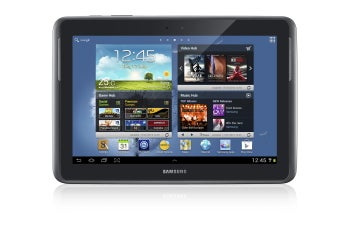

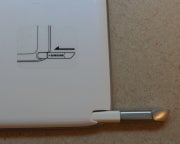
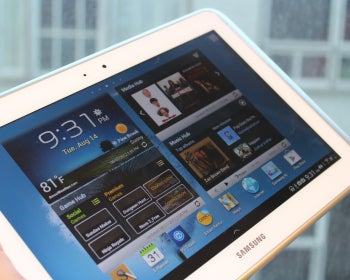
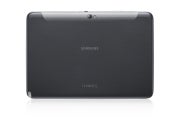
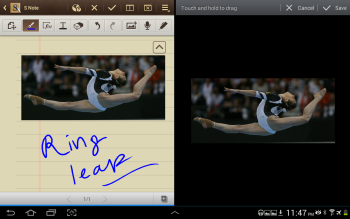
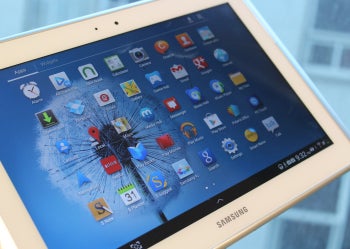
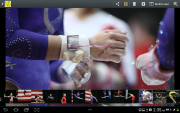
No comments:
Post a Comment